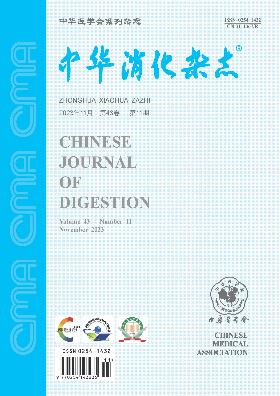Correlation between the severity of peptic ulcer bleeding and Helicobacter pylori type
引用次数: 0
Abstract
Objective To investigate the correlation between the severity of peptic ulcer bleeding (PUB) and the serum antibody typing of Helicobacter pylori (H.pylori). Methods From January 1, 2009 to December 31, 2018, at Guangzhou First People′s Hospital, 1 444 patients diagnosed with PUB and received H. pylori serum antibody test at the same time were enrolled and divided into high-risk group (324 cases) and low-risk group (1 120 cases) according to Forrest classification, and according to recurrent bleeding, the patients were divided into recurrent bleeding group (32 cases) and non-rebleeding group (1 412 cases). Serum H. pylori specific antibodies cytotoxin-associated gene A (CagA), vacuolating cytotoxin A (VacA) and urease were detected by protein array. The correlation between H. pylori positive rate, H. pylori type, PUB and rebleeding were analyzed. Chi-square test and logistic regression analysis were used for statistical analysis. Results Among 1 444 PUB patients, there were 709 patients with gastric ulcer bleeding (GUB) and 735 patients with duodenal ulcer bleeding (DUB). Previous history of peptic ulcer disease (odds ratio (OR)=1.501, P=0.006), the maximum diameter of ulcer over 2 cm (OR=2.484, P 0.05). According to H. pylori antibody type, H. pylori type Ⅰ infection was mainly in both high-risk group and low-risk group. The positive rate of H. pylori type Ⅰ strain of high-risk group was higher than that of low-risk group (67.28%, 218/324 vs. 60.45%, 677/1 120), and the difference was statistically significant (χ2=4.986, P=0.026). There was no statistically significant difference in the positive rate of H. pylori between GUB group and DUB group (68.41%, 485/709 vs. 68.57%, 504/735; χ2=0.005, P>0.05). Conclusions The infection of H. pylori is positively correlated with the severity of PUB, but not correlated with early ulcer rebleeding. H. pylori type Ⅰ is the main pathogenic strain of GUB and DUB, and CagA and VacA double positive strain is the most common strain. Key words: Helicobacter pylori; Urease; Peptic ulcer hemorrhage; Cytotoxin-associated gene A; Vacuolating cytotoxin A消化性溃疡出血严重程度与幽门螺杆菌类型的关系
目的探讨消化性溃疡出血(PUB)严重程度与幽门螺杆菌血清抗体分型的关系。方法选取广州市第一人民医院2009年1月1日至2018年12月31日诊断为PUB并同时行幽门螺杆菌血清抗体检测的患者1 444例,按Forrest分类分为高危组(324例)和低危组(1 120例),并根据再出血情况分为再出血组(32例)和非再出血组(1 412例)。采用蛋白阵列法检测血清幽门螺杆菌特异性抗体细胞毒素相关基因A (CagA)、空泡细胞毒素A (VacA)和脲酶。分析幽门螺杆菌阳性率、幽门螺杆菌类型、PUB与再出血的相关性。统计学分析采用卡方检验和logistic回归分析。结果1 444例PUB患者中,合并胃溃疡出血709例,合并十二指肠溃疡出血735例。既往消化性溃疡病史(优势比(OR)=1.501, P=0.006),最大溃疡直径大于2 cm (OR=2.484, P 0.05)。根据幽门螺杆菌抗体类型,幽门螺杆菌Ⅰ型感染主要发生在高危组和低危组。高危组幽门螺杆菌Ⅰ型检出率高于低高危组(67.28%,218/324比60.45%,677/1 120),差异有统计学意义(χ2=4.986, P=0.026)。GUB组与DUB组幽门螺杆菌阳性率比较,差异无统计学意义(68.41%,485/709 vs 68.57%, 504/735;χ2 = 0.005,P > 0.05)。结论幽门螺杆菌感染与PUB严重程度呈正相关,与早期溃疡再出血无关。幽门螺杆菌Ⅰ型是GUB和DUB的主要致病菌株,CagA和VacA双阳性菌株是最常见的菌株。关键词:幽门螺杆菌;脲酶;消化性溃疡出血;细胞毒素相关基因A;液泡细胞毒素A
本文章由计算机程序翻译,如有差异,请以英文原文为准。
求助全文
约1分钟内获得全文
求助全文

 求助内容:
求助内容: 应助结果提醒方式:
应助结果提醒方式:


